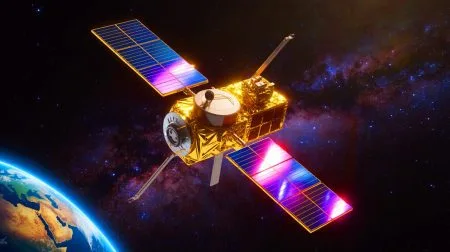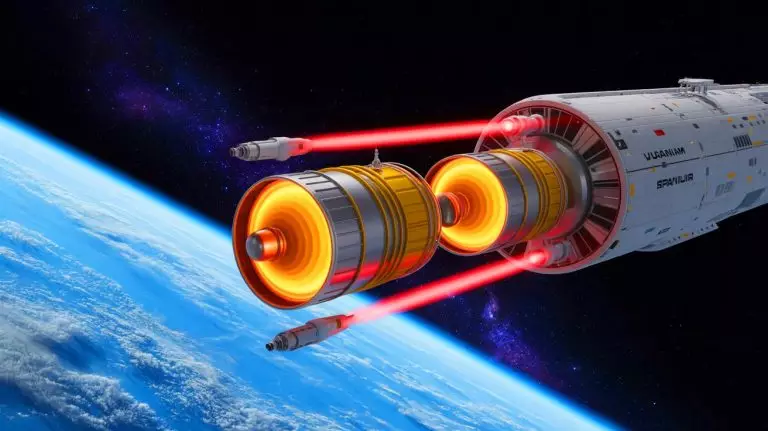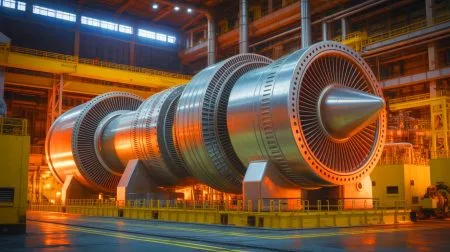| IN A NUTSHELL |
|
As chemical rockets push the boundaries of their capabilities, a new era of nuclear propulsion engines is emerging, potentially revolutionizing interplanetary travel. Researchers are developing cutting-edge technologies that could double current performance standards using rotating liquid uranium. This breakthrough could shorten travel times to distant planets, such as Mars, significantly enhancing our ability to explore the universe. In this article, we delve into the promise and challenges of these innovative propulsion systems, exploring how they might redefine space travel.
The Promise of Nuclear Thermal Propulsion
Since the dawn of space exploration, chemical rockets have been the mainstay of propulsion technology. However, after decades of refinement, these rockets have hit a technological ceiling, with their maximum efficiency—known as specific impulse—not exceeding 450 seconds. Even the top engineers at companies like SpaceX are now prioritizing cost reduction over pure thrust improvements. In response to this technological barrier, NASA and other agencies are turning to an alternative that, while conceived decades ago, has never been utilized in space: Nuclear Thermal Propulsion (NTP).
The DRACO program, led by NASA and DARPA, aims to test a nuclear engine by 2027, capable of achieving 900 seconds of specific impulse—double that of a chemical engine. But this might be just the beginning. A team of researchers from the University of Alabama in Huntsville and Ohio State University is developing an even more radical concept: the Centrifugal Nuclear Thermal Rocket (CNTR). According to their simulations, the CNTR could propel spacecraft with nearly four times the efficiency of chemical engines. This would be a tremendous advancement for Martian missions, provided they can overcome numerous technical challenges.
Rotating Liquid Uranium
The fundamental difference between a traditional NTP engine and a CNTR lies in the fuel. While conventional NTP systems use solid uranium, the CNTR relies on liquid uranium. This choice allows the rocket to operate at much higher temperatures, dramatically increasing thrust efficiency. But how can this fuel remain liquid? The answer is an integrated centrifuge. The rapid rotation confines the molten uranium using centrifugal force, forming a stable toroidal (ring-shaped) wall.
Gaseous hydrogen is then injected into the center of the system, passing through the hot uranium, heating to extreme temperatures, and then expelled through a nozzle to create thrust. The result is a specific impulse of 1,500 seconds, nearly double that of traditional NTP engines and half that of ion engines, but with significantly higher thrust. This innovative approach could transform human space exploration, making distant planets more accessible.
Promises and Major Challenges
Of course, such an innovation comes with its share of difficulties. The research team has identified ten major technical challenges, focusing on four in a recent scientific publication. The first challenge involves the system’s neutronics: byproducts of nuclear fission, like xenon and samarium, can “poison” the reactor, disrupting its operation. To address this, the researchers add elements like erbium-167 to stabilize temperature and explore strategies for selectively removing unwanted products.
The second issue is hydrogen bubbles. These bubbles are essential for heat transfer, but their behavior in liquid uranium is still poorly understood. To study them, the researchers have designed two experimental devices: Ant Farm (static) and BLENDER II (rotating, with X-ray observation). They use galinstan, a non-radioactive liquid metal, as a substitute for uranium, and nitrogen to simulate hydrogen.
Far from Launch, but on the Right Path
Currently, the CNTR remains a concept under development. No complete prototype has yet been built. The next steps will focus on laboratory testing of the DEP technology and improving the physical models of the engine. However, one thing is clear: if these obstacles can be overcome, the CNTR could represent a genuine revolution in interplanetary travel. Faster, more efficient, capable of carrying heavy loads over long distances—the centrifugal nuclear engine might be the key to reaching Mars and beyond.
As we stand on the brink of a new era in space exploration, the potential of nuclear propulsion systems is undeniable. With continued research and innovation, these technologies could pave the way for humanity’s journey to the stars. The question remains: Are we ready to embrace this bold leap into the future and unlock the mysteries of the cosmos?
Did you like it? 4.4/5 (27)







Wow, this spinning liquid uranium engine sounds straight out of a sci-fi movie! 🚀
How do they deal with the radiation from using uranium in space?
Is it really safe to have liquid uranium spinning around in a rocket? 🤔
Thanks for the article! This could be a game-changer for Mars missions.
I’m skeptical. Liquid uranium in space? Sounds too risky.
Is this technology going to be ready in our lifetime?
Fascinating read! This is the kind of innovation we need for interstellar travel. 🌌
So, when can we buy tickets to Mars with this engine? 😄
Interesting concept, but what are the environmental implications?
What happens if the centrifuge stops spinning? Does the uranium just float around?
Great to see new propulsion methods being explored. Exciting times!
Can this technology be used for missions beyond Mars?
How long before we see a prototype of this engine in action?
The technical challenges sound huge. Are we really close to a breakthrough?
Anyone else think this is just a pipe dream? 🤨
I hope they have a plan for dealing with nuclear waste in space.
Seems like a promising step forward for space exploration. Keep us updated!
Imagine the possibilities if this engine actually works! 🚀
How does this compare to other nuclear propulsion concepts?
I’m curious about the cost. Is this a feasible project financially?
Seems like Elon Musk would be interested in this tech for SpaceX. 🤔
Can these engines be used for cargo missions as well?
What are the risks involved with neutronics and hydrogen bubbles?
Is this just another hype, or actually a viable technology?
Why haven’t we seen more investment in nuclear propulsion before?
Are there any potential military applications for this technology?
Thank you for sharing this! Really opens the mind to future possibilities.
How does this propulsion system handle extreme space temperatures?
I’m all for innovation, but liquid uranium sounds terrifying! 😅
This might just be what humanity needs to become a multi-planetary species! 🌌
What if the uranium leaks? Sounds like a space disaster waiting to happen!
Only a 4 month trip now, instead of 8…
Sounds amazing 😆